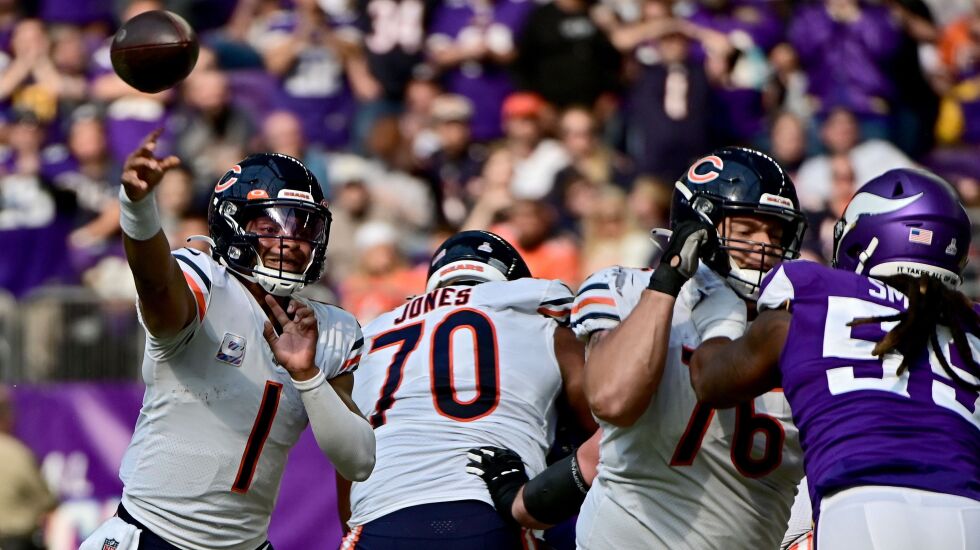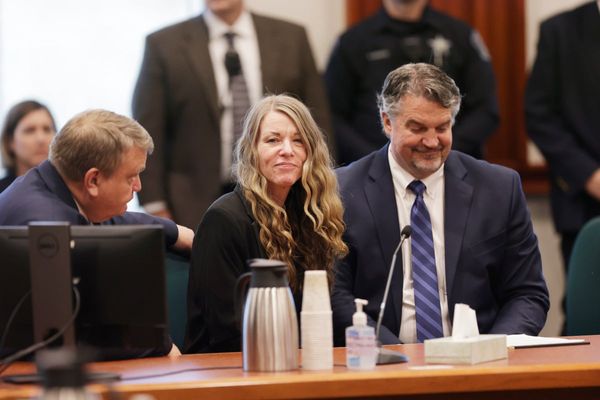
No one runs more than the Bears, and that won’t change anytime soon. Their 60.2% run rate is so much more frequent than any other team in the NFL — the Falcons rank second with 54.5% — that the Bears can be guaranteed of holding onto their crown through at least Halloween.
Sunday, though, was the Bears’ biggest step toward building balance.
Justin Fields is starting to resemble a modern quarterback driving a passing attack that, although it’s no one’s idea of futuristic, doesn’t seem trapped in the past the way it did at the end of September.
Over the Bears’ first three games, passing accounted for 29.6% of the Bears’ total yards. In the last two contests, 60.5% of the Bears’ yards have come through the air.
In the first three games — against the 49ers, Packers and Texans — the Bears threw on 28.3% of their downs. Against the Giants and Vikings, they’ve passed 40.2% of the time.
They’re not doing their best impression of a single-wing offense anymore.
“I just think it’s growing,” coach Matt Eberflus said Monday. “The guys are growing. The players are getting used to the scheme. The timing’s getting better, the rhythm’s getting better. ...
“You can feel Justin comfortable where he is right now in the offense.”
That cuts both ways, Eberflus said. With each passing week, the new coaching staff is learning how to best prepare the offense for the quarterback, learning “what guys are good at, and really playing to his strengths.”
The last few weeks, Eberflus said he’s seen Fields “taking command” at practice, telling receivers when their route depths are wrong and explaining to them the way he wants things done. Chicago has heard that line before — Mitch Trubisky was the king of Thursday back-field practices — but Fields is starting to transfer that comfort level to game day. He said after Sunday’s 29-22 loss that he felt as relaxed as he had all season. His 118.1 passer rating and 71.4 completion percentage were the best of his career, and his 208 passing yards was the fifth-best effort he’d given in 15 starts.
“I just felt poise, and him calm and confident back there,” Eberflus said.
Sunday’s pass-happy performance — by the Bears’ lowly standards — wasn’t a result of the team chasing points, either. The Bears were within at least one score of the Vikings — or ahead of them — for all but four-and-a-half minutes of the second half. Fields went 12-of-13 for 135 yards, one touchdown and a 135.5 passer rating in the second half
“To have that balance is good,” running back David Montgomery said. “It helps in the run game, and the run game helps the pass game. It helps in all facets of the game. You’ve got to be able to do both. We’re trending up to getting better in both.”
Not that anyone will mistake them for the “Greatest Show on Turf” Rams. Entering the Monday night game, NFL teams have thrown passes on 54.4% of their plays. Under first-time play-caller Luke Getsy, the Bears pass 39.8% of the time. That doesn’t count called passes that result in Fields scrambling or the quarterback getting sacked. The last two games alone, Fields ran on 13 called pass plays and was sacked eight times.
The pass game is becoming competent, which gives Getsy options. That, in turn, gives Fields a more honest chance to show the Bears what he can do — which is the entire point of the rebuilding season.
“You want to have balance, but you want to take what the defense gives you. …” Eberflus said. “It’s important to have all those weapons in your offense. We’re growing in that way, and we’re starting to see the benefit of that.”







